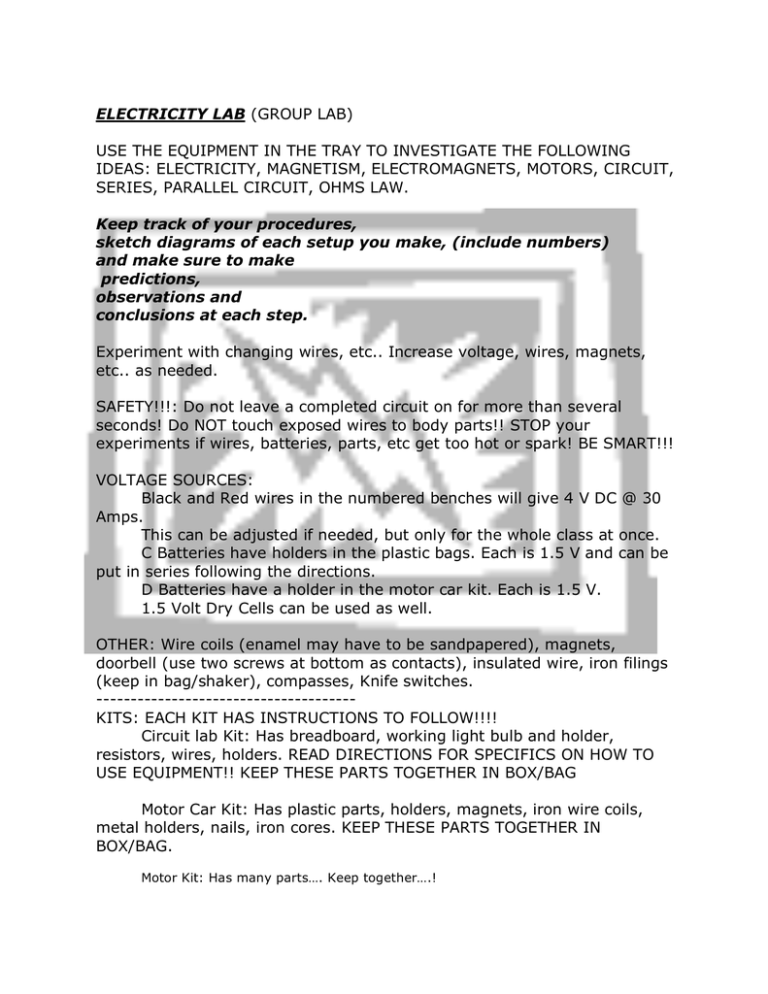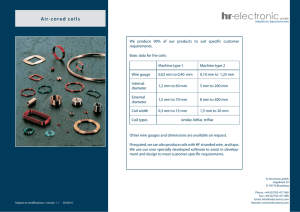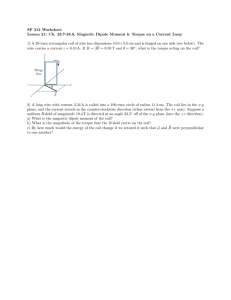electricity lab - New Haven Science
advertisement

ELECTRICITY LAB (GROUP LAB) USE THE EQUIPMENT IN THE TRAY TO INVESTIGATE THE FOLLOWING IDEAS: ELECTRICITY, MAGNETISM, ELECTROMAGNETS, MOTORS, CIRCUIT, SERIES, PARALLEL CIRCUIT, OHMS LAW. Keep track of your procedures, sketch diagrams of each setup you make, (include numbers) and make sure to make predictions, observations and conclusions at each step. Experiment with changing wires, etc.. Increase voltage, wires, magnets, etc.. as needed. SAFETY!!!: Do not leave a completed circuit on for more than several seconds! Do NOT touch exposed wires to body parts!! STOP your experiments if wires, batteries, parts, etc get too hot or spark! BE SMART!!! VOLTAGE SOURCES: Black and Red wires in the numbered benches will give 4 V DC @ 30 Amps. This can be adjusted if needed, but only for the whole class at once. C Batteries have holders in the plastic bags. Each is 1.5 V and can be put in series following the directions. D Batteries have a holder in the motor car kit. Each is 1.5 V. 1.5 Volt Dry Cells can be used as well. OTHER: Wire coils (enamel may have to be sandpapered), magnets, doorbell (use two screws at bottom as contacts), insulated wire, iron filings (keep in bag/shaker), compasses, Knife switches. -------------------------------------KITS: EACH KIT HAS INSTRUCTIONS TO FOLLOW!!!! Circuit lab Kit: Has breadboard, working light bulb and holder, resistors, wires, holders. READ DIRECTIONS FOR SPECIFICS ON HOW TO USE EQUIPMENT!! KEEP THESE PARTS TOGETHER IN BOX/BAG Motor Car Kit: Has plastic parts, holders, magnets, iron wire coils, metal holders, nails, iron cores. KEEP THESE PARTS TOGETHER IN BOX/BAG. Motor Kit: Has many parts…. Keep together….! (SKIP THIS PART IF DIRECTED OR DONE AS DEMO!) I) Investigate electric current and magnetic circuits for a short time. PUT IRON FILINGS BACK! field. Remember to only close Keep track of your procedures, sketch diagrams of each setup you make, (include numbers) and make sure to make predictions, observations and conclusions at each step. Using 3-4 Volts, 2 wires/leads with exposed ends. (switch?) ------------ (V) ------------Place some iron filings in between the two leads when the current is on. Observe the magnetic force of the wire on the filings. Does it change with distance? Voltage? Type of wire? Using 3-4 Volts, a (insulated) wire circuit placed through a horizontal cardboard square. Use iron filings and a compass to observe the strength, direction and pattern of the electromagnetic field. Use a wire wrapped about 25 times around an iron nail, and prove that you can make an electromagnet! Try seeing how direction, voltage, distance, turns affect the strength of the magnetic field. Put a connected wire loop in between two magnet sets to watch it move! Try seeing how direction, voltage, distance, turns affect the strength of the magnetic field. Remove the cover from a doorbell, and observe the electromagnets inside. Use the leads to make the doorbell ring, and write, observe its workings. Change voltage, distance to see the effect. II) INTRODUCTORY ELECTRONICS BASIC CIRCUITS: Use the Instruction Book As Needed! Keep track of your procedures, sketch diagrams of each setup you make, (include numbers) and make sure to make predictions, observations of brightness, current and conclusions at each step. Exp 1) Make a circuit with 3 V and a light bulb a) directly, b) through breadboard. Try different sockets to see if it makes a difference. Exp 2) Reverse the connections at the battery. Exp 3) Reverse the connections at the bulb. Exp 4) Repeat Exp 1. Put a 24 ohm resistor (red, yellow, black) (in between the + Voltage supply and the bulb) . Observe, and calculate the current now going through bulb. (V=IR) How much energy is lost? Where did it go? Exp 5) Unscrew bulb ¼ turn. Exp 6) Two 24 ohm resistors in series between voltage and bulb. Calculate current. Exp 7) Three 24 ohm resistors in series. Calculate current. Exp 8) Two 24 resistors in parallel. (SEE DIAGRAM!). Calculate current. (V=IR) 1/Rtot=1/R1+ 1/R2. Exp 9) Three 24 ohm resistors in parallel. (SEE DIAGRAM). Calculate current. EXP 10) Use 3 V +-+LED- ___> 220 ohm resistor - -3V. Observe brightness of LED, calculate current. EXP 11) Reverse direction with LED TRY OTHER COMBINATIONS OF RESISTORS, LED, LIGHT BULBS. Draw, sketch etc.. Make sure to only keep current on briefly in case you make a short circuit by mistake. DO OTHER EXPERIMENTS THAT SOUND INTERESTING FROM THE DIRECTIONS… ADVANCED: GO ONTO THE CIRCUIT/LOUDSPEAKER KIT III) MOTOR CAR: Use the Instruction Book As Needed! Keep track of your procedures, sketch diagrams of each setup you make, (include numbers) and make sure to make predictions, observations of brightness, current and conclusions at each step. Make the setup: car body, wire contacts, battery contact switches. Attach wire connectors, cut insulated wire. Make a coil with 50 turns, scrape off enameled wire. (See directions) 1) Connect coil to voltage source. Observe with/without. 2) Use coil to pick up filings/nails (with iron core). Calculate strength, based on distance. 3) Use different cores to test strength of electromagnet. 4) Use compass to test the strength of field with different cores. Check distance, direction, pattern of field. 5) Change voltage and repeat 2-4 to test strength of electromagnet. 6) Mount experiment frame, test strength of 50 vs. 200 turn coil. *** IF TIME 7) Assemble rotor. 8) Mount the field magnets. 9) Mount tires 10) Connect wire and rubber ring on pulley MAKE CAR GO! *** If time: Follow the directions to make a sample electric motor . BUILDING AN ELECTRIC MOTOR A coil of wire becomes an electromagnet when current passes through it. The electromagnet interacts with a permanent magnet, causing the coil to spin. Voila! You have created an electric motor. Wind the copper wire into a coil about 1 inch (2.5 cm) in diameter. Make four or five loops. Wrap the ends of the wire around the coil a couple of times on opposite sides to hold the coil together. Leave 2 inches (5 cm) projecting from each side of the coil, and cut off any extra. (See diagram.) If you are using insulated wire, strip the insulation off the ends of the wire projecting from the coil. If you are using enameled wire, use the sandpaper to remove the enamel. Color one side of one of the projecting ends black with the marking pen. (Note: It is very important that the orientation of the painted side corresponds to the orientation shown in the drawing below. If the coil is held in a vertical plane, paint the top half of one of the wires black.) Turn the cup upside down and place two magnets on top in the center. Attach three more magnets inside the cup, directly beneath the original two magnets. This will create a stronger magnetic field as well as hold the top magnets in place. Unfold one end of each paper clip and tape them to opposite sides of the cup, with their unfolded ends down. (See diagram.) Rest the ends of the coil in the cradles formed by the paper clips. Adjust the height of the paper clips so that when the coil spins, it clears the magnets by about l/l6 inch (1.5 mm). Adjust the coil and the clips until the coil stays balanced and centered while spinning freely on the clips. Good balance is important in getting the motor to operate well. Once you have determined how long the projecting ends of the coil must be to rest in the paper-clip cradles, you may trim off any excess wire. (The length of the projecting ends depends on the separation of the paper-clip cradles, which in turn depends on the width of the base of the cup you are using. See diagram.) If you are using a battery, place it in a battery holder. You can make your own from a block of wood and four nails, as shown in the diagram. Use the clip leads to connect the battery or power supply to the paper clips, connecting one terminal of the battery to one paper clip and the other terminal to the other paper clip. Give the coil a spin to start it turning. If it doesn’t keep spinning on its own, check to make sure that the coil assembly is well balanced when spinning, that the enamel has been thoroughly scraped off if enameled wire has been used, that the projecting end has been painted with black pen as noted, and that the coil and the magnet are close to each other but do not hit each other. You might also try adjusting the distance separating the cradles: This may affect the quality of the contact between the coil and the cradles. Keep making adjustments until the motor works. Have patience! The success rate with this design has been quite good. Current flows through the wire coil and creates an electromagnet. One face of the coil becomes a north pole, the other a south pole. The permanent magnet attracts its opposite pole on the coil and repels its like pole, causing the coil to spin. Another way to describe the operation of the motor is to say that the permanent magnets exert forces on the electrical currents flowing through the loop of wire. When the loop of wire is in a vertical plane, the forces on the top and bottom wires of the loop will be in opposite directions. These oppositely directed forces produce a twisting force, or torque, on the loop of wire that will make it turn Why is it so important to paint half of one projecting wire black? Suppose that the permanent magnets are mounted with their north poles facing upward. The north pole of the permanent magnet will repel the north pole of the loop electromagnet and attract the South Pole. But once the south pole of the loop electromagnet was next to the north pole of the permanent magnet, it would stay there. Any push on the loop would merely set it rocking about this equilibrium position. By painting half of one end black, you prevent current from flowing for half of each spin. The magnetic field of the loop electromagnet is turned off for that half-spin. As the south pole of the loop electromagnet comes closest to the permanent magnet, the paint turns off the electric current. The inertia of the rotating coil carries it through half of a turn, past the insulating paint. When the electric current starts to flow again, the twisting force is in the same direction as it was before. The coil continues to rotate in the same direction. In this motor, the sliding electrical contact between the ends of the coil of wire and the paper clips turns off the current for half of each cycle. Such sliding contacts are known as commutators. Most direct current electric motors use more complicated commutators that reverse the direction of current flow through the loop every half cycle. The more complicated motors are twice as powerful as the motor described here. This motor can also be used to demonstrate how a generator works. Try hooking up the ends of the paper clips to a sensitive galvanometer instead of the battery. Spin the coil and see if any current registers on the meter.




